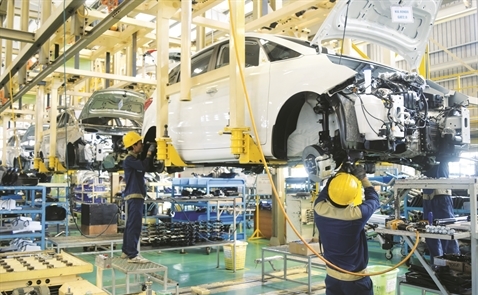Samsung Vietnam appoints its first Vietnamese senior executive
Samsung Vietnam appoints Nguyen Hoang Giang to SEVT senior leadership, the first Vietnamese executive in the company’s local manufacturing units.




Contrary to all predictions, automobile manufacturers have set modest targets for this year’s business plans. After a two-year boom, the automobile market is expected to be more quiet in 2017.

Contrary to all predictions, automobile manufacturers have set modest targets for this year’s business plans. After a two-year boom, the automobile market is expected to be more quiet in 2017.
2016 was a prosperous year for all automobile manufacturers and traders. Thaco, for example, reported profit of VND7.9 trillion, an increase of 12 percent compared with the year before, while Savico reported net profit of VND173 billion, an increase of 6.1 percent over 2015.
Analysts believe that the positive trend will continue in 2017.
However, automobile manufacturers have been very cautious about their business plans for 2017.
The automobile market witnessed a boom in 2015 and 2016 thanks to the commercial banks’ looser credit policies and high demand in the market, partially from the taxis of Grab and Uber.
The fact that automobile manufacturers have cut selling prices sharply has had a big impact on the market. Customers tend to delay their purchase plan until they can see more attractive prices.
Under free trade agreements, from 2018, the import tariff on CBU imports from ASEAN will be cut to zero percent, which will lower car prices by 20 percent. This has put pressure on domestic automobile enterprises.
Meanwhile, the government has shown its strong determination to apply Euro 4 emission standards from 2017 for cars with petrol engines, from 2018 for oil engine cars and from 2022 for trucks.
This will be a challenge for automobile manufacturers and may reduce consumption in the market.
Truong Hai predicted that the market sales in 2017 may fall by 10 percent to 205,000 products.
The lower demand would also force manufacturers to slash their selling prices.
Therefore, Truong Hai has estimated the sharp fall of 31 percent in turnover in 2017 in comparison with the last year.
The listing plan would be delayed so that the company can gather its strength to prepare for stiffer competition from 2018.
Savico has also foreseen tougher business in 2017 and 2018.
Though the company’s market share increased to 8.6 percent in 2016, its profit from automobile distribution decreased by 10 percent as Savico had to cut prices to scramble for customers.
In 2017, Savico will not only continue cooperation with loyal partners such as Toyota, Ford and GM, but will join the higher-end market segment by cooperating with Volvo.
After two years of witnessing sales soar as a result of the Ministry of Transport’s policy on tightening the control over overloading vehicles in circulation, Hoang Huy Investment & Service’s post-tax profit unexpectedly dropped by 71 percent in 2016.
Samsung Vietnam appoints Nguyen Hoang Giang to SEVT senior leadership, the first Vietnamese executive in the company’s local manufacturing units.
Michelin is undergoing a strong transformation by applying AI and smart analytic, helping lead the smart, safe, and sustainable mobility revolution in the Industry 4.0 era.
LG Innotek Vietnam Hai Phong secured a $200 million IFC loan as revenue slows, aiming to expand camera module production while meeting sustainability targets.
For Koen Soenens, Sales and Marketing Director at DEEP C, empathy is a compass that guides major deals, the way a leader builds a team, and the ambition to create a sustainable industrial zone that carries a Vietnamese identity.
Taseco Land has shifted its listing to HOSE and introduced a new upward-pointing arrow logo - a visual statement of its strategy to raise capital, expand its land bank, and strengthen its standing in Vietnam’s real estate sector
Located in the heart of Ho Chi Minh City, SAP Labs Vietnam is the second SAP Labs Network hub in Southeast Asia, following Singapore and is one of 20 countries that have SAP Labs globally.